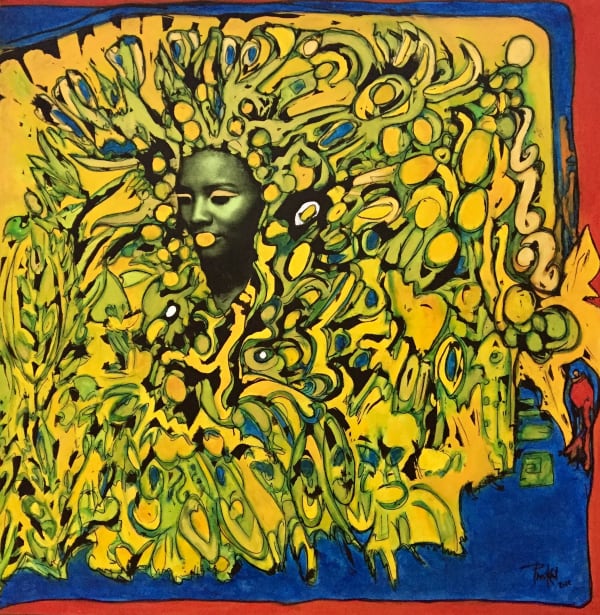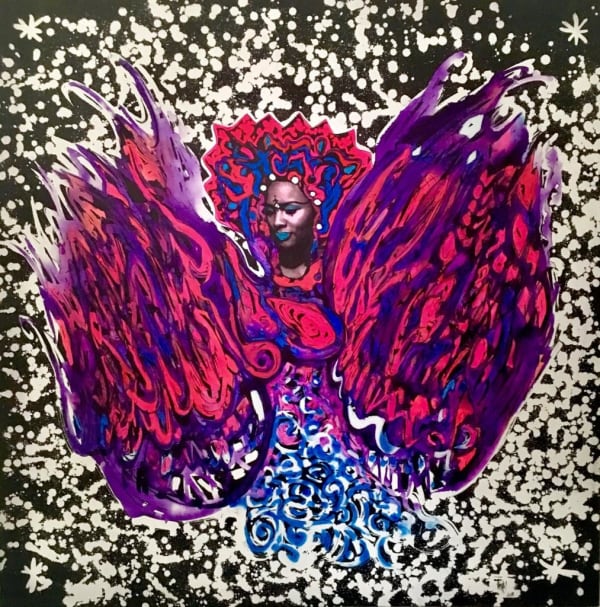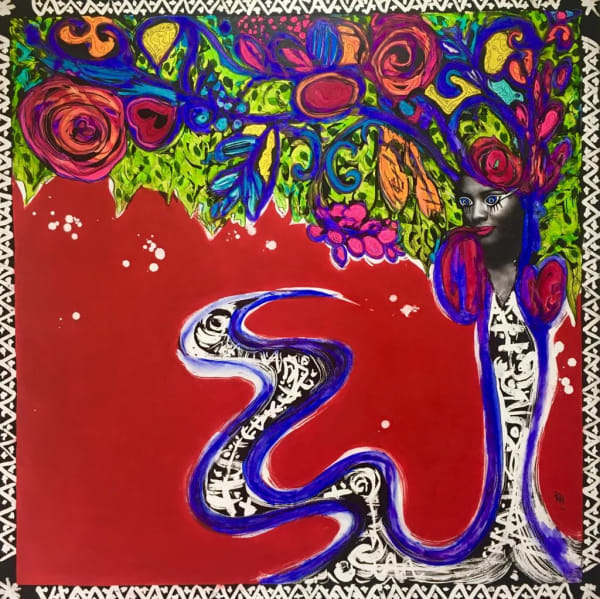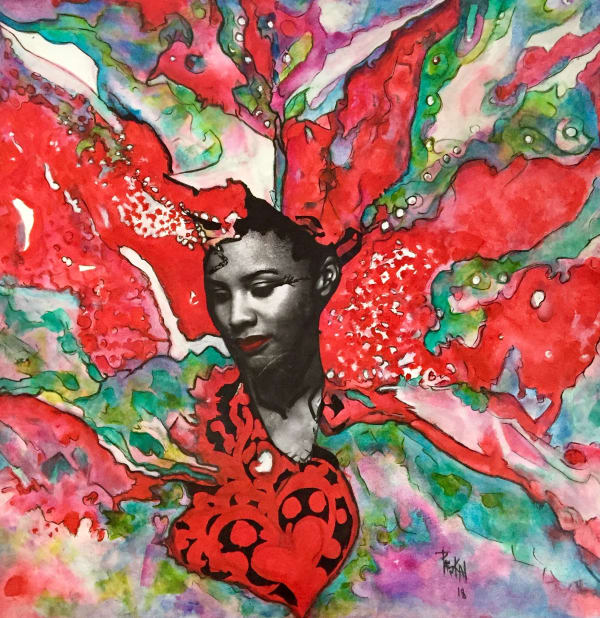Pascale FAUBLAS
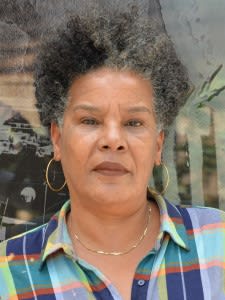
Born in Port-au-Prince on April 9, 1961, Pascale Faublas is the daughter of an entrepreneur father and an educator mother. Her passion for art manifested itself fifteen years after her participation in an artistic camp (TIMOUN ART) in Port-au-Prince on the initiative of Evelyne Liautaud who is involved in craftsmanship and Design creation. She learned sewing and drawing, and from there began a personal production (jewelry, necklaces, painting on furniture, on fabrics, pottery, etc.). However, she never attended an academic fine arts school.
After graduating from high school, Pascale Faublas moved to Canada in 1979 and obtained a diploma in hotel administration. From her experience in Montreal, which she left in 1983, she said: “I think Montreal opened my mind. Galleries, festivals, etc. It is the exploration of a larger framework. So different from Haiti. [1] The same year, she returned to Haiti and worked in the night hotel business. She spends her days alongside her sister-in-law Candide, a Frenchwoman practicing fabric painting. It was then that he felt the urge to undertake. She began with craftsmanship with paintings on furniture, fabrics, pottery, jewelry and then became interested in textile arts.
In 1984, she set up "Atelye kreyòl", a workshop for the production and promotion of crafts. She continues to explore her creative potential by devoting herself to fashion design and participates in a show afterwards. His favorite medium is fabric: clothes painted in acrylic, batik on fabrics, dyeing, tye and dye. In 1989, she opened a boutique-workshop in Thomassin (on the heights of Port-au-Prince). In addition to painting on fabric, she multiplies activities such as decorating interior objects, creating and selling voodoo crafts. It is also responsible for the promotion of artists of the Croix-des-bouquets and several artisans and thus allows them to participate in fairs and exhibitions.
In 1986, at the age of twenty-five, she met Martial Day, a massage therapist, with whom she married. Twelve years his senior, Martial introduced him to the country and took an interest in politics. At the time, the nationalist spirit and the prevailing militancy in favor of Haitianity pushed her to become more involved in society. She regularly participates in group events, literacy sessions, neighborhood associations, women's groups, etc. We find her at the front of the "Fanm d'Haiti" association, which is demonstrating for the involvement of women in society. For this occasion, she produced with Marie Louise Fouchard a large fresco on which we can read: “No to violence against women”. Since then, she regularly participates in demonstrations of solidarity with women.
The 1991 coup d'etat caused a virtual economic paralysis that was felt throughout the country. Pascale Faublas then devotes a larger part of her time to painting. She made her first individual exhibition at the Ateliers Jérôme in 1992. It is since this exhibition that she asserts herself as a visual artist and develops an original technique, made of collage of papers previously printed using techniques acquired in self-taught: ink , mixed media, scratching [2].
In 1995, Pascale Faublas participated in a duo in the creation of a mural for the 4th International Conference on Women in Beijing.
His work is located halfway between craftsmanship and contemporary visual arts. His work is based on a search for materials and materials from his environment. Based on the principles of the art of salvage, she uses both human-made objects, plant debris, and animal bones. Pascale thus continues her reflection on the cultural and ethnological roots of Haiti, while leaving the viewer the opportunity to read their own interpretation. "I don't want to lock the other's gaze into my personal project. The main thing is to discover the other's perception and not to impose mine on him. The artist keeps repeating at any interview she gives. Undoubtedly, we can read the reason why the majority of his paintings have no title ...
In 1997, she exhibited solo for the first time at the Center d'Art thanks to the contact of the painter Burton Chenet (1958-2012) who introduced her to Francine Murat, the director of the time.
Separated from her husband in 1998, she decided to settle in Jacmel to reopen the Atelye Kreyòl there. She also coordinates a group of Jacmelian artisans whom she influences to enrich, develop and improve the quality of local crafts, then mainly made up of papier-mâché masks, woodworking and model ships. In the meantime, very active on the local and international scene, she participates in several group exhibitions. In Haiti, her work is shown at MUPANAH, at the Marassa gallery, at the Haitian Art Museum of the College Saint Pierre and at the Ethno-Design gallery in Pétion-Ville where she exhibits permanently. In France, it is on the Roof of the Grande Arche, (Paris), and at the Municipal Library of Nantes that the public can admire his work.
In 2004, on the occasion of the bicentenary of Haiti’s independence and as part of the Haiti en Seine demonstration, she exhibited alongside Chantal Regnaut, and Elodie Barthélémy, at Crédit Municipal de Paris.
Following the devastating earthquake of January 12, 2010, Pascale moved to Cayes-Jacmel (Timouillage). That same year, she exhibited in Suresnes (France) and signed up with the American department store chain MACY’S for two years to coordinate the production of decorative papier mâché objects.
Pascale returned to Port-au-Prince in 2015 and focused on purely artistic production. It ceases all artisanal activity with the exception of a few contracts for interior decoration of hotels or carnival stands.
In 2016, she returned to the Art Center to improve her personal training and reconnect with other artists. She took the opportunity to take drawing lessons from live models with Pascale Monnin, the monotype workshop with Killy (Patrick Ganthier) and the linocut workshop with Marie-Hélène Cauvin. She also runs creative workshops with "Fanm" associations and directs the production of a collective fresco against violence against women, commissioned from the Art Center by the UNDP and the Canadian Embassy.
In addition to her talents as a visual artist, Pascale Faublas occupies a small role in the cinema, in the film Ayiti mon amour by Guetty Félin, which will be shortlisted for the 2018 Oscars in the category of best foreign film.
Through the craftsmanship of her works combining among other things recovery, collages, ink, wood and burnt paper, Pascale Faublas is recognized for her work that she signs PASKAL and which brings a revival in the contemporary Haitian artistic landscape. The self-taught plastic artist is today a central figure in Haitian craftsmanship for these actions in favor of its preservation, transmission and sustainability.
Pascale Faublas lives and works in Haiti.
EXHIBITIONS
Individual
Années 2010
– 2017, Un hamac dans l’eau, espace Fouchard, Nérette, Pétion-Ville, Haïti.
– 2013, Parchemins, Les Ateliers Jérôme, Port-au-Prince, Haïti.
Années 2000
– 2006, Transformation des anges, Médiathèque Alexandre-Dumas, Villers Cotterets, France.
– 2006, Transformation des anges, La nouvelle Galerie, Villers-Cotterets, France.
– 2001, «…Lumières…», Ethno-Galerie, Pétion-Ville. Haïti.
Années 1990
– 1998, Terres brûlées, Ethno-Galerie, Pétion-Ville. Haïti.
– 1997, 223e exposition du Centre d’Art, Œuvres de Pascale Faublas, Le Centre d’Art, Port-au-Prince, Haïti.
– 1992, Le Passage à l’œuvre d’art, Les Ateliers Jérôme, Port-au-Prince, Haïti.
Collectives
Années 2010
– 2018, 271e exposition du Centre d’Art, exposition-vente de créations contemporaines, Le Centre d’Art, Port-au-Prince, Haiti.
– 2016, Veus de Dones : Haïti Pas A Pas, La Casa d’Haïti, CCCB de Barcelone, Espagne.
– 2015, 7e forum transculturel d’art contemporain, Fondation AfricAmerica, Aquin, Haïti.
– 2015, « 1 » : A Contemporary Art Exhibit, Villa Kalewès, Pétion-Ville, Haïti.
– 2015, PluriELLEs, Villa Kalewès, Pétion-Ville, Haïti.
– 2014, Rencontre, Musée du Panthéon National Haïtien, (MUPANAH), Port-au-Prince, Haïti.
– 2014, Transformations, Villa Kalewès, Pétion-Ville, Haïti.
– 2013, 3rd Ghetto Biennale, Port-au-Prince, Haïti.
– 2012, L’art haïtien vu par nos femmes, Musée du Panthéon National Haïtien, (MUPANAH), Port-au-Prince, Haïti.
– 2010, 6e édition de Ti coup d’œil sur Haïti, festival des arts et des traditions populaires haïtiens, Médiathèque de Suresnes, Île-de-France, France.
Années 2000
– 2007, 2eédition du festival CuturElles, Institut Français d’Haïti, Port-au-Prince, Haïti.
– 2004, Transformation des anges, œuvres contemporaines, Crédit Municipal de Paris, espace Griffon, Paris, France.
– 2000, Héritage de couleurs, Ethno-Galerie, Pétion-Ville. Haïti.
Années 1990
– 1999, L’art de la récupération et la ville, Les Ateliers Jérôme, Port-au-Prince, Haïti.
– 1999, Mises en demeure, Ethno-Galerie, Pétion-Ville. Haïti.
– 1998, Formes et couleurs sur papier, Musée du Panthéon National Haïtien, (MUPANAH), Port-au-Prince, Haïti.
– 1998, Haïti au toit de la grande Arche, Toit de la grande Arche de la défense, Paris, France.
– 1998, Haïti, femmes et création, Bibliothèque municipale de Nantes, Nantes, France.
– 1997, Exposition collective avec les sculpteurs Nasson et Ti Pélin, Atelye Kreyòl, Pétion-Ville, Haïti.
– 1995, Pascale Faublas, Edner Joseph, une étroite complicité, Les Ateliers Jérôme, Port-au-Prince, Haïti.
– 1995, Retour de Beijing ; 4e conférence internationale sur les femmes à Beijing, Pékin, Chine.
– 1995, Dessins et collages, Les Ateliers Jérôme, Port-au-Prince, Haïti.
– 1994, Exposition de pré-sélection de la 2e édition de la biennale de peinture de la Caraïbe et de l’Amérique Centrale de Santo-Domingo, Musée d’Art Haïtien du Collège Saint-Pierre, Port-au-Prince, Haïti.
– 1994, Solidarite ak Simon Josué (Solidarité avec Simon Josué), Les Ateliers Jérôme, Port-au-Prince, Haïti.
– 1993, Œuvres de groupe, Les Ateliers Jérôme, Port-au-Prince, Haïti.
– 1993, Vyolans kont fanm (Violence contre les femmes), Hôtel Christopher, Port-au-Prince, Haïti.
– 1992, Le symbolisme de la croix, Musée d’Art Haïtien du Collège Saint-Pierre, Port-au-Prince, Haïti.
Année 1980
– 1985, Variation en noir et blanc, Gingerbread, Port-au-Prince, Haïti.
Craft exhibition
Année 1990
– 1990, Présentation Atelye Kreyol, masques, pagnes, foulards, Hôtel Ollofson, Port-au-Prince, Haïti.
Années 1980
– 1989, Exposition. Ouverture boutique Atelye kreyòl, Pétion-Ville, Haïti.
– 1985, Présentation de vêtements, Maison privée Elsie Martin, Port-au-Prince, Haïti.
– 1984, Présentation de vêtements, Club de Pétion-Ville, Pétion-Ville, Haiti.
Auction
– 2017, Haïti : l’exception artistique, Art Haïtien de 1940 à nos jours, PIASA en partenariat avec Le Centre d’Art, Paris, France.
Publications:
Ouvrages
– THEARD Marie Alice. Présence féminine dans l’art haïtien, imprimé sur les presses de Print Lt, Haïti, avril 2013.
-STEPHENSON Barbara Prézeau. 15 ans d’art contemporain en Haïti 2000-2015, Fondation Afric America, European Graphics : Belgique. Octobre 2014.
Catalogues d’exposition
– Haïti : l’exception artistique, Art Haïtien de 1940 à nos jours, PIASA en partenariat avec Le Centre d’Art de Port-au-Prince, 14-19 octobre 2017
– Drap Art, Festival international, Barcelone décembre 2016.
– Rencontre, Musée du Panthéon National Haïtien, (MUPANAH), Port-au-Prince, Haïti, 13 août-30 septembre 2014.
– L’art haïtien vu par nos femmes, Musée du Panthéon National (MUPANAH), 8 mars 2012 – 8 avril 2012.
– L’art de la Récupération et la Ville, Les ateliers Jérôme, 23 Novembre – 11 décembre 1999.
– Haïti au toit de la Grande Arche, Toit de la Grande Arche de la Défense, Paris, septembre 1998.
Revues
– Institut Français d’Haïti, Revue Conjonction : n° 205 (2000).
– Enfofanm, Ayiti Fanm : vol. 3, n°5, janvier-février-mars 1993.
– Enfofanm, vol. 2, n°4, juillet-décembre 1992.
Presse
– AUGUSTIN Gary, Pa janbe ; renouveler les matériaux et le support, Le Nouvelliste.
– DB, Pascale Faublas et Edner Joseph en symbiose, le Nouvelliste, 23 août 1995.
– FLORVIL H., Où va la jeune peinture haïtienne ?, Le Nouvelliste du 11 au 15 février 1994.
– GAETJENS Prince, Pascale Faublas : des œuvres qui nous jugent, Le Nouvelliste, du 23 au 26 décembre 1999.
– HENRIQUEZ Pradel, Pascale Faublas et Edner Joseph aux Ateliers Jérôme, le Nouvelliste, 21 août 1995.
– JOSEPH Nélio, Parchemins : mémoire et symboles, Le Nouvelliste du samedi 14 et dimanche 15 décembre 2013.
– ROCHE Jacques, Les décombres de Pascale et de Patrick, Le Nouvelliste, 29 novembre 1999.
– SAINT-ELOI Rodney, La nouvelle peinture : aventure singulière, le Nouvelliste du jeudi 23 décembre au dimanche 26 décembre 1993.
Écriture journalistique
– Marie-Lucie Vendryes, démarche artistique, août 1996.
Filmographie
– COHEN Hervé, Paskal en attendant les anges, documentaire, 10 mn, 2004.
– FELIN Guetty, Ayiti, mon amour, long-métrage, 88 mn, 2018.
WEBOGRAPHIE
– http://lenouvelliste.com/lenouvelliste/article/125103/Parchemins-memoire-et-symboles
– http://www.lenational.org/hamac-leau-force-de-lutopie/
– http://www.kolektif509.com/exhibits
– https://www.mutualart.com/Artist/Pascale-Faublas/D81AAF19941CF234
– http://www.loophaiti.com/content/95-oeuvres-de-60-artistes-haitiens-dans-une-vente-aux-encheres-paris
– http://www.haitilibre.com/docs/carifesta-XII_programme/PAP-Triomphe.pdf
– https://www.africamerica.org/attachment/566431/
– http://lenouvelliste.com/lenouvelliste/article/125103/Parchemins-memoire-et-symboles.html
– http://leNouvelliste.com/public/article/116994/presence-feminine-dans-lart-haitien

